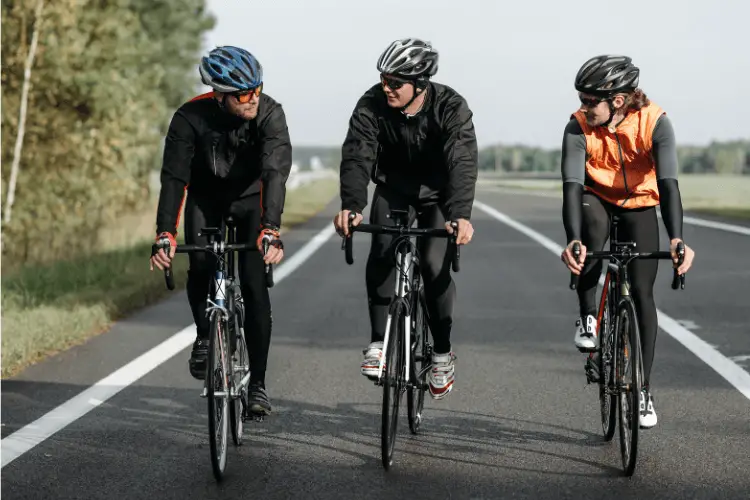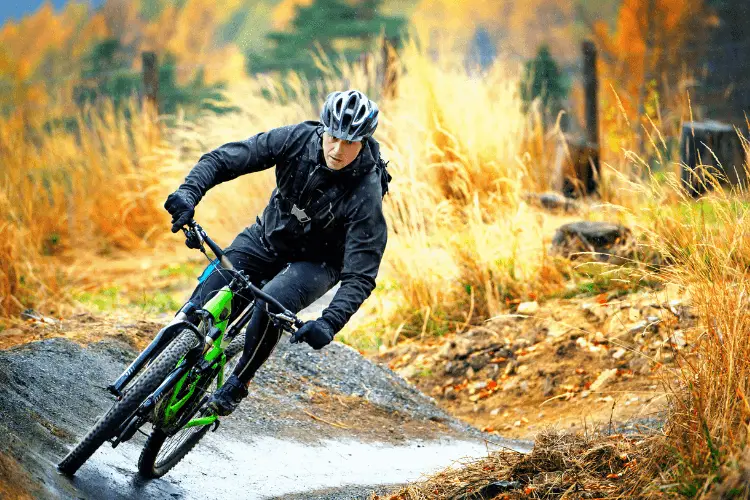Cycling in windy weather is one of the hardest tasks for bike riders. It is not just difficult but also dangerous. You will find yourself battling with crosswinds or moving towards headwinds.
Cycling in rain or snow is unpleasant, but the wind can propel you along at great speeds or slow you down. So how much wind is too much for cycling?
Riding under a 20MPH wind is not too hazardous, but it can sway your bike a bit. At 30MPH, cycling under this wind speed can be quite difficult, even for the most experienced rider.
In this article, we will consider why it isn’t easy to ride against the wind and what is regarded as a strong wind for cycling.
Quick Navigation
Why Is It Difficult To Ride Against The Wind?
This is because the blowing wind exerts pressure on us and opposes the direction of the motion of the bike. The rider will have to pedal hard to progress the cycle forward against the direction of the wind.

Riding a bike in the direction of a blowing wind is relatively easy because the wind exerts pressure in the same direction you’re moving. But when riding against the wind, the reverse is the case.
When you ride against the wind, your bike is repelled by the wind’s pressure, making it hard to pedal.
This will result in losing half of your speed to headwinds. Also, the route on which you’re playing can make it difficult to ride against the wind.
Even though the route has an end, a headwind can last a while, and a change of direction is not guaranteed to change it.
You can make it easy for yourself by selecting a gear that lets you pedal against the wind with ease.
Also, mind the route you follow when the wind picks up so you can protect yourself against the wind while you ride.
We have another article on how long does it take to bike 10 miles. So you can also read it now.
Is It Safe to Ride A Bike in High Winds?
No. It’s not safe to ride a bike in high winds. It can be miserable and very dangerous. If you want a quiet ride, you must find a route that’s not exposed.

Riding a bike in high winds is not safe and not advisable because small debris or branches can blow in your face and obscure your vision, leading to an accident.
If you notice the wind has hit a speed of 20 MPH while riding, you need to stop riding as this can cause trees to sway, pushing leaves and branches within the riding path.
But if you choose to ride in high winds, the amount of wind you can deal with will depend on your riding skills, the type of bike you ride, and the types of risks you can take.
Whatever you decide to do, know your risk-taking level and limits, so you don’t lose control of your bike while riding.
How Hard is the Ride With a Headwind?

The experience of riding into a headwind can be demoralizing. It can feel as though you are riding uphill.
Even though you know a hill has an end, the headwind just keeps going on until you change direction or stop moving.
While this wind blows, you can’t do anything to stop its path or reduce its efficacy. But the way you deal with it can impact its effect on the ride.
Here are some tips to combat the hardship of riding with a headwind:
- Use other riders to shelter yourself against the wind and make pedaling easier.
- Reduce increased wind resistance by reducing your drag and your frontal area.
- Reduce any excess material that will flap in the wind
- Manage your gear wisely during the ride. If you notice the wind a mile ahead, use a gear that will be easy to pedal
- Use a pre-ride checker to check your route so you can plan your ride and what route to follow
- Prepare yourself mentally for the battle ahead
What Is Considered A Strong Wind For Cycling?
A wind moving at 30 MPH wind is considered a strong wind and would be very difficult to cycle under, even for experienced riders. At this point, debris, trees, rocks, mailboxes, and waste bins would fly around, and the pressure would most likely turn you into traffic.

Every rider’s power, abilities, and strength differ, and that’s why each rider would witness a different scenario.
Some riders may find the ride easy, while others would find it more challenging.
Whatever the situation, any wind above 5 MPH can be noticeable at different levels and can obstruct riders.
Is 10 mph Wind Strong For Cycling?
A 10 mph wind is not that much of strong wind for experienced cyclists, but if you’re a beginner or lightweight rider, it could impact your riding and slow you down. Overall, a 10mph wind shouldn’t cause many issues.
Is 15 mph Wind Strong For Cycling?
Here is the point at which many cyclists would notice changes in wind speed and struggle.
However, it’s not strong enough to distort an experienced rider’s move unless you build endurance and strength.
At this wind speed, the more force you apply, the headwind begins to feel more natural.
Can You Bike in 20 mph Wind?
Yes, you can, but you might not enjoy it. This wind level will cut your overall speed in half, even at the same energy you used to pedal.
So imagine that you’re going at 15mph into a 20mph wind. You’ll find yourself moving at 5mph as if you’re walking.
If you see a 20 MPH wind up ahead, you can decide to turn around and move back. You can then enjoy the effect of the wind behind you.
How Do You Ride A Bike In A Windy Condition?
A good way to ride in windy conditions is to bend over your handlebars to reduce wind pressure. Also, try not to wear anything that would trap the wind or act like a sail.

You won’t be able to avoid biking in windy conditions always because they’re a natural occurrence and can prop up anytime, especially when you’re short of time.
However, following these steps, you can learn to ride in windy conditions.
Lower Your Gear
The first thing you should do when you notice the wind is not working for you is to reduce your gear lower than you usually ride.
Imagine how you shift gears when climbing a hill. That’s exactly what you need here. You will have to sacrifice speed for endurance so your leg will not tire out.
Execute Aerodynamics
At this point, you’ll have to execute your knowledge of aerodynamics. If you’re going to face the strong wind for an extended period, you should limit anything that will cause drag while you ride.
It would be best if you avoided anything that will billow around you as it will create a parachute effect that slows you down.
Lay Low
While you’re riding, try to make yourself as small as possible. Put yourself in a tucked position that will help propel you while you’re facing the headwind.
This would reduce the amount of surface the wind will challenge, which means less resistance against the wind. You can also master training with a drop bar handle for the period.
Beware of Gust
Watch out for wind gusts while you’re riding. A gust of wind can knock you off balance after taking out your handlebars. So be aware of this move and be alert while you ride.
Conclusion
If you’re a beginner, don’t be afraid to cancel your riding session if you feel uncomfortable by the wind.
As you improve in experience, you will witness several windy conditions that will help you grow into the situation.
With time you’ll not just become comfortable with riding, but you’ll also develop the necessary confidence to ride when it’s not too safe.
